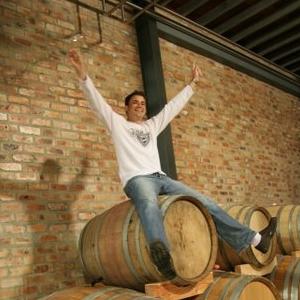The term ‘flying winemaker’ was first used in the UK in the late 1980’s to describe a team of young Australians brought in to help with a Northern Hemisphere vintage in France at a time when they were relatively idle in their home country. They brought with them plenty of modern ideas, new technology, up-to-date techniques and were instrumental in improving and upgrading the quality of many European wines, noticeably those from less ‘smart’ appellations such as Vin de Pays.
Over the years, many winemakers have managed to work two vintages a year, sometimes owning vineyards in two different hemispheres like Jeff Grier from Villiera and Domaine Grier or buying in grapes as Eben Sadie started out doing in Priorat in Spain. Most flying winemakers come from New World countries such as Australia, New Zealand, South Africa and America and most head for European vineyards to work their extra vintage. To find a Frenchman abandoning the cold French winter to head to sunny South Africa, whilst sounding eminently sensible, is almost unheard of.
Julien Schaal first came to South Africa as a student and worked alongside Gordon Newton Johnson and his now-wife, Nadia at Hamilton Russell. For most of the year, he makes wine on his father-in-law’s farm in Alsace, but twice a year, he flies to South Africa to make a spicy Shiraz and a truly delicious Chardonnay – legacies of student days in the Rhone and Burgundy. The Chardonnay has been the attention-grabber so far and picked up five stars in the latest Platter Wine Guide. He uses grapes from the same vineyard area as Bouchard Finlayson – Kaaimansgat – but this will be the last year he does so as the vineyard is now virus-infected and he can’t get healthy grapes.
Julien is a very ‘un-French’ Frenchman who has a refreshingly honest approach to life and winemaking. He is happy to label many French winemakers as arrogant and bewails the lack of passion amongst his peers who work in family-owned wineries making wine in the same ways as they have done for the last few centuries – “Age isn’t always a guarantee of quality. It can be, but sometimes it is just better to start afresh with a new vineyard.”
Having said that, his wine is made in very traditional ways – all wild yeasts, whole-bunch pressing and biodynamic farming methods as far as possible. His Chardonnay is fermented and aged in larger-than-normal oak barrels – hardly any of them new as Julien doesn’t believe that new oak can fully integrate in the ten months he keeps his wine in the wood – and is only released after further aging in the bottle.
The result is a glorious mouthful of perfectly balanced flavours, textures and experiences with yellow fruit, lively acidity and creamy oak all melding into a lengthy and incredibly drinkable wine. Available from boutique wine shops – try Carolines Fine Wine Cellars – for around R130, the 2009 was one of my highlights of 2010.

